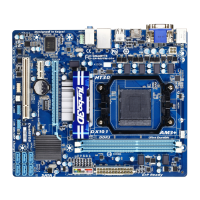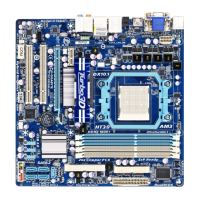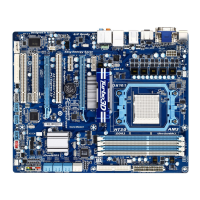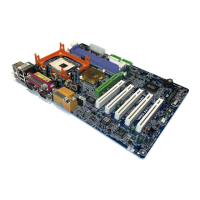Do you have a question about the Gigabyte GA-880GM-USB3 and is the answer not in the manual?
Essential guidelines for safe and proper motherboard installation to prevent damage.
Detailed technical specifications of the GA-880GM-USB3 motherboard.
Step-by-step instructions for installing the CPU and its cooler.
Guide on installing DDR3 memory modules and configuring dual channel.
Procedure for installing expansion cards like graphics or network cards.
Instructions for configuring the ATI Hybrid CrossFireX for enhanced graphics performance.
Description and function of all ports and connectors located on the motherboard's back panel.
Identification and function of internal connectors on the motherboard for various components.
Overview of the initial screens displayed during the computer's boot process.
Explanation of the BIOS Setup main menu navigation and function keys.
Advanced settings for CPU, memory clocks, frequencies, and voltages for performance tuning.
Configuration of system date, time, and basic hardware settings like IDE devices.
Settings for boot order, virtualization, CPU features, and onboard graphics.
Configuration of onboard devices like SATA controllers, LAN, audio, and USB.
Settings related to ACPI sleep states, power button behavior, and wake-up events.
Management of Plug and Play (PnP) and PCI slot resource assignments (IRQ).
Monitoring of system voltages, temperatures, fan speeds, and hardware thermal control.
Restores the BIOS to the most stable, minimal-performance factory default settings.
Restores the BIOS to factory default settings for optimal performance.
Setting passwords to restrict access to BIOS Setup or system boot.
Saves current BIOS settings and exits the BIOS Setup program.
Exits BIOS Setup without saving any changes made to the settings.
Guide to installing chipset drivers from the motherboard driver disk for system stability.
Overview of GIGABYTE utilities and free software available on the driver disk.
Information on accessing application guides, driver disk content, and motherboard manuals.
Contact information for GIGABYTE headquarters and branch offices for support.
Displays basic system information about the installed hardware and software.
Link to GIGABYTE website for downloading the latest BIOS, drivers, and applications.
Quick link to GIGABYTE's latest developed utilities for installation.
Utility for quick system data backup and restoration, supporting NTFS, FAT32, FAT16.
Tools like Q-Flash and @BIOS for easy system BIOS updates, enhanced by DualBIOS™.
Software for fine-tuning system settings, overclocking, and monitoring hardware in Windows.
Technology for delivering power savings and enhancing efficiency through software control.
Tool for convenient data sharing between computers on the same network.
Function to quickly create backups of changed data files or copy files from a backup.
Easy-to-use tool for enabling system power savings via a Bluetooth cell phone.
Steps to install, configure SATA controller mode, and set up RAID arrays for hard drives.
Guide to setting up multi-channel audio configurations, S/PDIF, Dolby features, and microphone recording.
Common issues and solutions, including FAQs and a troubleshooting procedure flowchart.
Information on environmental directives, RoHS, WEEE, and safety compliance.
| Number of memory slots | 4 |
|---|---|
| Maximum internal memory | 16 GB |
| Supported memory clock speeds | 1066, 1333, 1800 MHz |
| Processor socket | Socket AM3 |
| Processor manufacturer | AMD |
| Maximum number of SMP processors | 1 |
| USB 2.0 connectors | 3 |
| S/PDIF out connector | Yes |
| Number of SATA connectors | 5 |
| USB 2.0 ports quantity | USB 2.0 ports have a data transmission speed of 480 Mbps, and are backwards compatible with USB 1.1 ports. You can connect all kinds of peripheral devices to them. |
| USB 3.2 Gen 1 (3.1 Gen 1) Type-A ports quantity | 2 |
| Audio chip | Realtek ALC892 |
| Power source type | ATX |
| Motherboard chipset | AMD 880G |
| Audio output channels | 7.1 channels |
| Motherboard form factor | micro ATX |
| Compatible operating systems | Windows 7, Vista, XP |
| Parallel processing technology support | Not supported |
| Bundled software | Norton Internet Security |
| Networking features | Gigabit Ethernet |
| ACPI version | 1.0 |
| BIOS memory size | 16 Mbit |
| Width | 244 mm |
|---|











